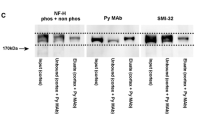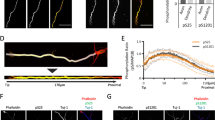Summary
Neurofilament subunits in rat dorsal root ganglion (DRG) neurons were examined using five antibodies: NFH, RT97 and NFHP recognise the 200 kDa subunit (NF200); NFH recognises both phosphorylated and non-phosphorylated forms of NF200 whereas RT97 and NFHP are specific for the phosphorylated and non-phosphorylated forms respectively; 155 and anti-68 kD recognise the 155 kDa and 68 kDa subunits respectively. All the antibodies apart from NFHP distinguished between the two populations of neurons corresponding to the light (L) and small dark (SD) cell types as previously shown for RT97. This demonstrates that L and SD neurons contain different levels of neurofilament and that the ability to discriminate between them is not unique to the antibody RT97. It is also evident that DRG neurons contain neurofilament composed of all three subunits. Since NFH and RT97, but not NFHP, distinguished between the two populations, it appears that it is the presence of the phosphorylated form of NF200 that provides the basis for discrimination between the two cell types. After dephosphorylation of the neurofilament, NFHP also discriminated between the two populations, indicating that there is more NF200 regardless of phosphorylation state in the L neurons.
Observations made from unfixed DRGs indicate that all neurons contain some neurofilament and the neurofilament rich and neurofilament poor populations were also apparent.
The use of colchicine apparently caused a small increase in neurofilament levels in at least some perikarya, presumably due to its blocking effect on axoplasmic transport. This caused some SD neurons to become neurofilament rich.
We conclude that L neurons contain more neurofilament than SD neurons since both cell types contain non-phosphorylated NF200, but the L neurons also contain a much greater amount of the phosphorylated form.
Similar content being viewed by others
References
Anderton, B. H., Breinberg, D., Downes, M. J., Green, P. J., Tomlinson, B. E., Ulrich, J., Wood, J. N. &Kahn, J. (1982) Monoclonal antibodies show that neurofibrillary tangles and neurofilaments share antigenic determinants.Nature 298, 84–6.
Andres, K. H. (1961) Untersuchungen den Feinbau von Spinal Ganglien.Zeitschrift für Zellforschung und mikroskopische Anatomie 55, 1–48.
Breen, K. C., Robinson, P. A., Wion, D. &Anderton, B. H. (1988) Partial sequence of rat heavy neurofilament peptide (NF-H): identification of putative phosphorylation sites.FEBS Letters 241, 213–18.
Dahl, D. (1983) Immunohistochemical differences between neurofilaments in perikarya, dendrites and axons.Experimental Cell Research 149, 397–408.
Dahl, D., Labkovsky, B. &Bignami, A. (1988) Neurofilament phosphorylation in axons and perikarya: immunofluorescence study of the rat spinal cord and dorsal root ganglia with monoclonal antibodies.Journal of Comparative Neurology 271, 445–50.
Debus, E., Flugge, G., Weber, K. &Osborn, M. (1982) A monoclonal antibody specific for the 200K polypeptide of the neurofilament triplet.EMBO Journal 1, 41–5.
Delacourte, A., Filliatreau, G., Boutteau, F., Biserte, G. &Schrevel, J. (1980) Study of the 10-nm-filament fraction isolated during the standard microtubule preparation.Biochemical Journal 191, 543–6.
Duce, I. &Keen, P. (1977) An ultrastructural classification of the neuronal cell bodies of the rat dorsal root ganglion using zinc iodide-osmium impregnation.Cell and Tissue Research 185, 263–77.
Ferri, G. L., Sabani, A., Abelli, L., Polak, J. M., Dahl, D. &Portier, M. M. (1990) Neuronal intermediate filaments in rat dorsal root ganglia: differential distribution of peripherin and neurofilament protein, immunoreactivity and effect of capsaicin.Brain Research 515, 331–5.
Goldstein, M. E., Cooper, H. S., Bruce, J., Carden, M. J., Lee, V. M. -Y. &Schlaepfer, W. W. (1987) Phosphorylation of neurofilament proteins and chromatolysis following transection of rat sciatic nerve.Journal of Neuroscience 7, 1586–94.
Goldstein, M. E., Weiss, S. R., Lazzarini, R. A., Shneid-Man, P. S., Lees, J. F. &Schlaepfer, W. W. (1988) mRNA levels of all three neurofilament proteins decline following nerve transection.Molecular Brain Research 3, 287–92.
Hauch, M. C., Probst, A., Ulrich, J., Kahn, J. &Anderton, B. H. (1986) Alzheimer neurofibrillary tangles contain phosphorylated and hidden neurofilament epitopes.Journal of Neurology, Neurosurgery and Psychiatry 49, 1213–20.
Hoffman, P. N., Lasek, R. J., Griffin, J. W. &Price, D. L. (1983) Slowing of the axonal transport of neurofilament proteins during development.Journal of Neuroscience 3, 1694–700.
Lawson, S. N. (1979) The postnatal development of large light and small dark neurons in mouse dorsal root ganglia: a statistical analysis of cell numbers and size.Journal of Neurocytology 8, 275–94.
Lawson, S. N. &Waddell, P. J. (1991) Soma neurofilament immunoreactivity is related to cell size and fibre conduction velocity in rat primary sensory neurons.Journal of Physiology 435, 41–63.
Lawson, S. N., Caddy, K. W. T. &Biscoe, T. J. (1974) Development of rat dorsal root ganglion neurones. Studies of cell birthdays and changes in mean cell diameter.Cell and Tissue Research 153, 399–413.
Lawson, S. N., Harper, A. A., Harper, E. I., Garson, J. A. &Anderton, B. H. (1984) A monoclonal antibody against neurofilament protein specifically labels a subpopulation of rat sensory neurones.Journal of Comparative Neurology 228, 263–72.
Moss, T. H. &Lewkowicz, S. J. (1983) The axon reaction in motor and sensory neurones of mice studied by a monoclonal antibody marker of neurofilament protein.Journal of the Neurological Sciences 60, 267–80.
Price, J. (1985) An immunohistochemical and quantitative examination of dorsal root ganglion neuronal subpopulations.Journal of Neuroscience 5, 2051–9.
Rosenfeld, J., Dorman, M. E., Griffin, J. W., Ludwig, J. W., Sternberger, N. H. &Price, D. L. (1987) Distribution of neurofilament antigens after axonal injury.Journal of Neuropathology and Experimental Neurology 46, 269–82.
Sharp, G. A., Shaw, G. &Weber, K. (1982) Immunoelectronmicroscopical localisation of the three neurofilament triplet proteins along neurofilaments of cultured dorsal root ganglion neurones.Experimental Cell Research 137, 403–13.
Shaw, G. &Weber, K. (1981) The distribution of the neurofilament triplet proteins within individual neurones.Experimental Cell Research 136, 119–25.
Shaw, G., Osborn, M. &Weber, K. (1981) An immunofluorescence microscopical study of the neurofilament triplet proteins, vimentin and glial fibrillary acidic protein within the adult rat brain.European Journal of Cell Biology 26, 68–82.
Thorey, I. &Seifert, W. (1989) Developmentally regulated epitopes on a neurofilament protein visualized by monoclonal antibodies.Developmental Brain Research 49, 229–41.
Vitadello, M., Triban, C., Fabris, M., Dona, M., Gorio, A. &Schiaffino, S. (1987) A developmentally regulated isoform of 150,000 molecular weight neurofilament protein specifically expressed in autonomie and small sensory neurons.Neuroscience 23, 931–41.
Wood, J. N. &Anderton, B. H. (1981) Monoclonal antibodies to mammalian neurofilaments.Bioscience Reports 1, 263–8.
Yamadori, T. (1970) A light and electron microscopic study on the postnatal development of spinal ganglia in rats.Acta Anatomica Nipponica 45, 191–204.
Author information
Authors and Affiliations
Rights and permissions
About this article
Cite this article
Perry, M.J., Lawson, S.N. & Robertson, J. Neurofilament immunoreactivity in populations of rat primary afferent neurons: A quantitative study of phosphorylated and non-phosphorylated subunits. J Neurocytol 20, 746–758 (1991). https://doi.org/10.1007/BF01187848
Received:
Revised:
Accepted:
Issue Date:
DOI: https://doi.org/10.1007/BF01187848




